Coleoptera
Beetles
David R. Maddison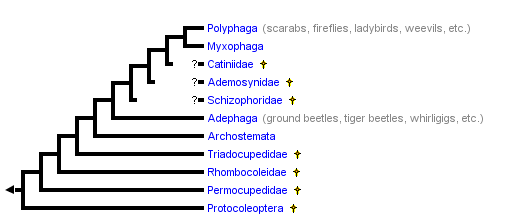


This tree diagram shows the relationships between several groups of organisms.
The root of the current tree connects the organisms featured in this tree to their containing group and the rest of the Tree of Life. The basal branching point in the tree represents the ancestor of the other groups in the tree. This ancestor diversified over time into several descendent subgroups, which are represented as internal nodes and terminal taxa to the right.

You can click on the root to travel down the Tree of Life all the way to the root of all Life, and you can click on the names of descendent subgroups to travel up the Tree of Life all the way to individual species.
For more information on ToL tree formatting, please see Interpreting the Tree or Classification. To learn more about phylogenetic trees, please visit our Phylogenetic Biology pages.
close boxIntroduction
The Coleoptera, or beetles, includes many commonly encountered insects such as ladybird beetles (family Coccinellidae), click beetles (Elateridae), scarabs (Scarabaeidae), and fireflies (Lampyridae). They live throughout the world (except Antarctica), but are most speciose in the tropics.
The oldest beetle fossils are from the Lower Permian (about 265 million years old; Ponomarenko, 1995); since then the group has diversified into many different forms. They range in size from minute featherwing beetles (Ptiliidae), adults of which are as small as 0.3 mm long, to the giant Goliath and Hercules beetles (Scarabaeidae), which can be well over 15 cm. While most species are phytophagous, many are predacious, or fungivores, or are parasitoids. They communicate to one another in many ways, either by use of chemicals (e.g. pheromones), sounds (e.g. stridulation), or by visual means (e.g. fireflies). They live in rainforest canopies, the driest deserts, in lakes, and above treeline on mountains.
In one sense the most unusual property of beetles is not some aspect of their structure or natural history, but their sheer number. There are more known species of Coleoptera than any other group of organisms, with over 350,000 described species. Perhaps the most famous quote about beetles comes from the great population geneticist J.B.S. Haldane, who was asked what might be learned about a Creator by examining the world. His response: "an inordinate fondness for beetles" (Fisher, 1988).
Characteristics
The most distinctive feature of beetles is the hardening of the forewings into elytra; it is from this that they get their formal name (koleos - sheath, pteron - wing). The elytra serve to protect the more delicate hind wings, as well as the dorsal surface of the abdomen, and may have been a key factor allowing them to exploit narrow passageways (for example, in leaf litter and under bark). During flight the forewings are opened enough to allow the hind wings to unfold and function:

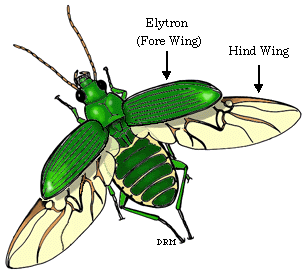
Other derived characteristics of beetles are:
- hind wings folded under elytra, with reduced venation
- hind two thoracic segments (mesothorax+metathorax=pterothorax) broadly connected with abdomen, so that the primary functional units of body are head / prothorax / pterothorax + abdomen, rather than the more typical head / thorax / abdomen of many other insects.
- genitalia retracted into abdomen
- adult antenna with 11 articles
Beetles are holometabolous insects, normally with adecticous, exarate pupae. Most species have chewing mouthparts. There is a gula present on the undersurface of the head.
The Suborders of Coleoptera
The four living suborders of beetles diverged from one another in the Permian and early Triassic, and are substantially different from one another. Adults differ in the structure of the prothorax, hind wing, abdomen, ovary, testes, and so on. The major differences are summarized in a table.
Polyphaga is by far the largest suborder, containing 85% of the known species, including rove beetles, scarabs, stag beetles, metallic wood-boring beetles, click beetles, fireflies, blister beetles, mealworms, ladybirds, leaf beetles, longhorn beetles, and weevils. Many are phytophagous. Adephaga includes ground beetles, tiger beetles, predacious diving beetles, and whirligig beetles; most adephagans are predacious. Myxophaga is a small suborder, containing less than 100 known species, whose members are small or minute, and associated with hygropetric habitats, drift material, or interstitial habitats among sand grains. Archostemata contains several families of beetles, most associated with wood; members of this family are somewhat similar to some of the earliest, Paleozoic beetle fossils.
Discussion of Phylogenetic Relationships
Compared to the other four large orders of insects (Hemiptera, Hymenoptera, Diptera, and Lepidoptera), the phylogenetic relationships of the major lineages of beetles are relatively poorly known. Only recently has some of the morphological data been examined phylogenetically (e.g., Beutel, 1997; Beutel and Haas, 2000), and molecular sequence information is only now being gathered.
There are several competing hypotheses regarding subordinal relationships. The two most widely discussed differ most strikingly in their placement of the suborder Polyphaga: this suborder is either the sister group of Myxophaga (Crowson, 1960, 1981; Machatschke, 1962; Klausnitzer, 1975; Beutel, 1997; Beutel and Haas, 2000), or the sister group of all remaining beetles (Lawrence and Newton, 1982; Kukalová-Peck and Lawrence, 1993), as shown in the following two figures:



Left: "Polyphaga+Myxophaga" hypothesis, right: "Basal Polyphaga" hypothesis of relationships among suborders of beetles.
Evidence for a close relationship of Polyphaga to Myxophaga includes the shared reduction in the number of larval leg articles (Crowson, 1960, 1981). Klausnitzer (1975) further considered the Adephaga as sister to Myxophaga + Polyphaga, based on completely sclerotized elytra, reduced number of crossveins in the hind wings, and folded (as opposed to rolled) hind wings of those three suborders.
Evidence for the alternative hypothesis, that Polyphaga is the sister group to remaining beetles, is based primarily on characters of wing structure, and on the loss of the cervical sclerites in the three suborders other than Polyphaga (Lawrence and Newton, 1982; Kukalová-Peck and Lawrence, 1993).
Recent cladistic analyses of some of the morphological data (Beutel, 1997; Beutel and Haas, 2000) supports the Polyphaga + Myxophaga hypothesis.
The composition of the clade Coleoptera is not in dispute, with the exception of the twisted-wing parasites, Strepsiptera. These odd insects have been regarded as related to the beetle families Rhipiphoridae and Meloidae, with which they share first instar larvae that are active, host-seeking triungulins and later instar larvae that are endoparasites of other insects (Crowson, 1981), or as the sister group of beetles (e.g. Kukulová-Peck and Lawrence, 1993), or more distantly related to insects (see further discussion in Strepsiptera).
References
Arnett, R.H. 1973. The Beetles of the United States (A manual for identification). The American Entomological Institute, Ann Arbor, Michigan.
Arnold'di, L.V., V.V. Zherikhin, L.M. Nikritin, and A.G. Ponomarenko (eds.). 1977. Mezozoiskie Zhestkokrylye. Akademiya Nauk SSSR, Trudy Paleontologicheskogo Instituta, Vol. 161. Nauka Publishers, Moscow.
Arnold'di, L.V., V.V. Zherikhin, L.M. Nikritin, and A.G. Ponomarenko (eds.). 1992. Mesozoic Coleoptera. Smithsonian Institution Libraries, Washington, D.C. (English translation of Arnold'di et al., 1977.)
Beutel, R. 1997. Über Phylogenese und Evolution der Coleoptera (Insecta), insbesondere der Adephaga. Abhandlungen des Naturwissenshaftlichen Vereins in Hamburg, 31:1-164.
Beutel, R., and F. Haas. 2000. Phylogenetic relationships of the suborders of Coleoptera (Insecta). Cladistics, 16:103-141.
Boving, A.G. and F.C. Craighead. 1931. An illustrated synopsis of the principal larval forms of the order Coleoptera. The Brooklyn Entomological Society, Brooklyn, N.Y.
Caterino, M.S., V. L. Shull, P. M. Hammond and A. P. Vogler. 2002. Basal relationships of Coleoptera inferred from 18S rDNA sequences. Zoologica Scripta 31:41-49.
Crowson, R.A. 1955. The natural classification of the families of Coleoptera. N. Lloyd, London.
Crowson, R.A. 1960. The phylogeny of Coleoptera. Annual Review of Entomology, 5:111-134.
Crowson, R.A. 1981. The biology of the Coleoptera. Academic Press, London.
Fisher, R.C. 1988. An inordinate fondness for beetles. Biological Journal of the Linnean Society, 35:313-319.
Hlavac, T.F. 1972. The prothorax of Coleoptera: origin, major features of variation. Psyche 79(3): 123-149.
Hlavac, T.F. 1975. The prothorax of Coleoptera: (Except Bostrichiformia - Cucujiformia). Bulletin of the Museum of Comparative Zoology 147(4): 137-183.
Joy, N.H. 1976. A practical handbook of British beetles. E. W. Classey, Faringdon, England.
Kirejtshuk, A.G. 1992. Evolution of mode of life as the basis for division of the beetles into groups of high taxonomic rank. Pp. 249-261 in M. Zunino, X. Bellés and M. Blas (eds.), Advances in Coleopterology. European Association of Coleopterology, Barcelona.
Klausnitzer, B. 1975. Probleme der Abgrenzung von Unterordnungen bei den Coleoptera. Entomologische Abhandlungen staatliches Museum für Tierkunde in Dresden, 40:269-275.
Kukalová-Peck, J. and J.F. Lawrence. 1993. Evolution of the hind wing in Coleoptera. The Canadian Entomologist, 125:181-258.
Lawrence, J.F., and Britton, E.B. 1994. Australian Beetles. Melbourne University Press, Carlton, Victoria.
Lawrence, J.F., and A.F. Newton, Jr. 1982. Evolution and classification of beetles. Annual Review of Ecology and Systematics, 13:261-290.
Lawrence, J.F., and A.F. Newton, Jr. 1995. Families and subfamilies of Coleoptera (with selected genera, notes, references and data on family-group names). Pp 779-1006 in Pakaluk and Slipinski (1995).
Lawrence, J.F., S.A. Slipinski, and J. Pakaluk. 1995. From Latreille to Crowson: a history of the higher-level classification of beetles. Pp 87-154 in Pakaluk and Slipinski (1995).
Machatschke, J.W. 1962. Bemerkungen zum System der Coleoptera. Tag. Ber. Dtsch. Akad. Landwiss. Berl. 45:121-137.
Pakaluk, J. and S.A. Slipinski (eds.) 1995. Biology, Phylogeny, and Classification of Coleoptera. Papers Celebrating the 80th Birthday of Roy A. Crowson. Muzeum i Instytut Zoologii PAN, Warszawa.
Ponomarenko, A.G. 1969. Historical development of the Coleoptera - Archostemata. Trudy Paleontologicheskogo Instituta Akademiya Nauk SSSR, 125:1-240. [In Russian]
Ponomarenko, A.G. 1971. The geological history and evolution of beetles. Proc. Int. Congr. Entomol., 13th, Moscow, 1: 281.
Ponomarenko, A.G. 1995. The geological history of beetles. Pp. 155-171 in Pakaluk and Slipinski (1995).
Smith, S.G. and N. Virkki. 1978. Coleoptera. Animal Cytogenetics, volume 3, Insecta 5. Gebrüder Borntraeger, Berlin.
White, R.E. 1983. A field guide to the beetles of North America. Houghton Mifflin, Boston.
Information on the Internet
- Assembling the Beetle Tree of Life (BToL).
- The Coleopterists Society.
- The Coleoptera Home Page.
- Beetles (Coleoptera) and Coleopterists. Zoological Institute of the Russian Academy of Sciences.
- Beetles. By A. Bochdansky & M. Kriftner
- Water Beetle World. The newsletter for aquatic Coleoptera workers.
- Water Beetles (Coleoptera) on the Net. Checklist, bibliography.
- Coleoptera families (INBIO, Costa Rica).
- Checklist of Beetles of Canada and Alaska.
- A Distributional Checklist of the Beetles (Coleoptera) of Florida.
- Coleoptera of Rhode Island: An on-line database.
- The Beetles of the Virgin Islands.
- Southeast Asian Beetles.
- A Wild Beetle Chase. A short film about the work of coleopterist Michael Ivie.
- Shapes and Colors from the World of Beetles. Thais Entomology.
- An Inordinate Fondness for Beetles (A. V. Evans & C. L. Bellamy).
Title Illustrations

| Scientific Name | Temnoscheila |
|---|---|
| Location | USA: Arizona: Tucson |
| Specimen Condition | Dead Specimen |
| Image Use |
 This media file is licensed under the Creative Commons Attribution License - Version 3.0. This media file is licensed under the Creative Commons Attribution License - Version 3.0.
|
| Copyright |
© David R. Maddison

|
| Scientific Name | Hydroscapha natans |
|---|---|
| Location | USA: Arizona: Sycamore Canyon |
| Specimen Condition | Live Specimen |
| Image Use |
 This media file is licensed under the Creative Commons Attribution License - Version 3.0. This media file is licensed under the Creative Commons Attribution License - Version 3.0.
|
| Copyright |
© 2001 David R. Maddison

|
| Scientific Name | Bembidion confusum |
|---|---|
| Location | USA: Iowa: Manchester |
| Sex | Male |
| Image Use |
 This media file is licensed under the Creative Commons Attribution License - Version 3.0. This media file is licensed under the Creative Commons Attribution License - Version 3.0.
|
| Copyright |
© 2004 David R. Maddison

|
| Scientific Name | Priacma serrata |
|---|---|
| Specimen Condition | Live Specimen |
| Sex | Male |
| Image Use |
 This media file is licensed under the Creative Commons Attribution License - Version 3.0. This media file is licensed under the Creative Commons Attribution License - Version 3.0.
|
| Copyright |
© 1996 David R. Maddison

|
About This Page
David R. Maddison

Oregon State University
Page copyright © 1995 David R. Maddison
 Page: Tree of Life
Coleoptera. Beetles.
Authored by
David R. Maddison.
The TEXT of this page is licensed under the
Creative Commons Attribution License - Version 3.0. Note that images and other media
featured on this page are each governed by their own license, and they may or may not be available
for reuse. Click on an image or a media link to access the media data window, which provides the
relevant licensing information. For the general terms and conditions of ToL material reuse and
redistribution, please see the Tree of Life Copyright
Policies.
Page: Tree of Life
Coleoptera. Beetles.
Authored by
David R. Maddison.
The TEXT of this page is licensed under the
Creative Commons Attribution License - Version 3.0. Note that images and other media
featured on this page are each governed by their own license, and they may or may not be available
for reuse. Click on an image or a media link to access the media data window, which provides the
relevant licensing information. For the general terms and conditions of ToL material reuse and
redistribution, please see the Tree of Life Copyright
Policies.
- First online 16 November 1994
- Content changed 11 September 2000
Citing this page:
Maddison, David R. 2000. Coleoptera. Beetles. Version 11 September 2000 (under construction). http://tolweb.org/Coleoptera/8221/2000.09.11 in The Tree of Life Web Project, http://tolweb.org/




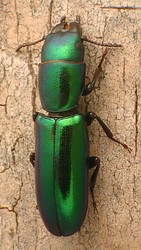
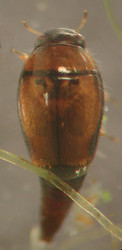
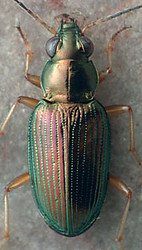
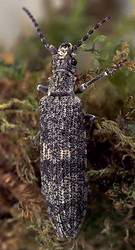





 Go to quick links
Go to quick search
Go to navigation for this section of the ToL site
Go to detailed links for the ToL site
Go to quick links
Go to quick search
Go to navigation for this section of the ToL site
Go to detailed links for the ToL site